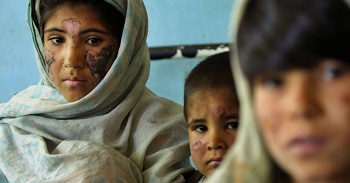Leishmania tropica complex - Clinical Manifestations, Cutaneous, Diffuse cutaneous, Leishmaniasis recidivans, Oriental sore
Clinical Manifestations of Leishmania tropica complex
The clinical manifestations of Leishmania tropica complex are as follows:
Leishmania tropica syndromes
Leishmania tropica complex is responsible for clinical syndromes including:
Cutaneous leishmaniasis
Diffuse cutaneous leishmaniasis
Leishmaniasis recidivans
Cutaneous leishmaniasis (CL)
Cutaneous leishmaniasis is the most common form of leishmaniasis caused by Leishmania tropica complex
usually occurs in children and young adults
syndromes of CL include causes skin lesions, mainly ulcers, on exposed parts of the body
these ulcers leave life-long scars, serious disability, or social stigma
the typical manifestation of CL is oriental sore
Oriental sore
the incubation period for oriental sore caused by Leishmania tropica complex may range from 2 months to 4 months
it is a typical ulcerative lesion that occurs on the skin
the syndrome begins as a single, red, pruritic papule at the site of the bite i.e. at the site of inoculation
as the size of the papule increases, it becomes crusted and eventually ulcerates and this ulcer is called an oriental sore
the oriental sore is circular, shallow, and may measure around 2 cm with a base formed by granulation tissue and erythematous elevated margin
the base of the ulcer may contain the amastigote forms of the parasite
as the disease progresses, the ulcer produces serous or seropurulent discharges which may result in the formation of scales or crusts
the ulcer may also cause secondary infections such as streptococcal and staphylococcal infections
regional lymphadenopathy caused by Leishmania tropica complex is mostly unusual
in some cases, the ulcer has lasted for 1 year to 2 years, and healing leaves behind small, flat, and depigmented scar

Image: Cutaneous leishmaniasis (Source: WHO)
Diffuse cutaneous leishmaniasis
usually, diffuse cutaneous leishmaniasis condition arises in hosts with poor immune response and is allergic
the disease due to Leishmania tropica complex begins as a localized papule, lacks ulceration, and satellite lesions may appear around the papule in the skin
the amastigotes can metastasize to the face and other extremities
as this is a chronic infection, the syndromes may last 20 or more years
the Leishmania skin test is negative in these cases
Leishmaniasis recidivans
Leishmaniasis recidivans condition arises years after localized cutaneous leishmaniasis caused by Leishmania tropica complex has healed
reactivation of dormant parasites or a new infection from a different species may cause Leishmaniasis recidivans
the lesions appear on the face most commonly and the mucous membrane is also involved which may result in the destruction of the nose
aside from the host nose, it may also involve the mouth and throat and may lead to the partial or total destruction of mucous membranes
as this is a chronic infection, the syndromes may last 20 or more years
few parasites may be present in the ulcer and the Leishmania skin gives positive results indicating an exaggerated delayed hypersensitivity reaction
Leishmania major syndromes
The clinical syndromes of Leishmania major are as follows:
Leishmania major is the causative agent of zoonotic cutaneous leishmaniasis
the incubation period may range from 2 weeks to 6 weeks
similar to another cutaneous leishmaniasis, the lesions begin with multiple papules which rapidly clear (within 2-3 weeks)
the lesions occur in the lower extremities and are surrounded by a layer of hyperaemic inflammatory infiltrate, and undermined ragged edges
the chronic ulcer typically heals within 3 months to 6 months, leaving behind a scar
regional lymphadenopathy and satellite ulcers are associated with Leishmania major infections
Leishmania aethiopica syndromes
The clinical syndromes of Leishmania aethiopica are as follows:
Leishmania aethiopica causes cutaneous leishmaniasis which is chronic
may be complicated by the development of diffuse cutaneous leishmaniasis
disfiguring nodules are present all over the body
these nodules contain a large number of amastigotes
involvement of cell-mediated immunity is either reduced or absent